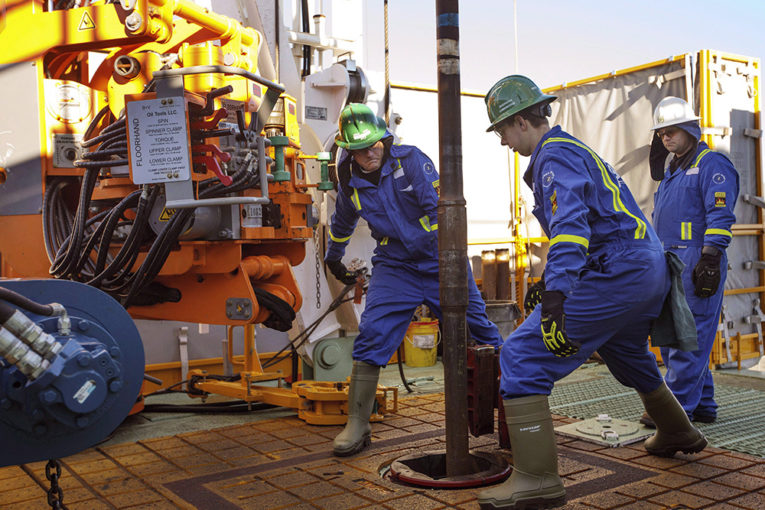
An energy convoy is headed out of Western Canada these days, but it’s not the high-profile cavalcade now making its way to Parliament Hill.
More drilling rigs from Canada are relocating to the United States, where activity is bustling and the oilfield services sector is seeing stronger demand than it is north of the 49th parallel.
Western Energy Services Corp. said this week it moved a drilling rig into the Permian Basin in Texas earlier this year, bolstering its American fleet to eight rigs.
On Thursday, Precision Drilling Corp. said it moved one high-spec rig into the U.S. during the third quarter and is now relocating a second one — the two are destined for Pennsylvania and Texas — as U.S. producers are willing to pay about $1.25 million each to relocate the units south and get them to work.
Precision, the country’s largest driller, is also eyeing the potential for more machinery to trek southward as the U.S. oilpatch is enjoying better times and paying higher rates than in Canada.
“It’s the polar opposite of sentiment,” Precision CEO Kevin Neveu said in an interview from Houston, when asked to compare the two markets.
“We don’t wake up one morning and decide to move rigs, but we wait until we can find customers who will pay for the move and will sign the rigs up on long-term contracts.
“If we achieve that, then we will move a rig to satisfy that demand.”
This week’s developments continue a disquieting trend that has been unfolding for the past three years, with some of the most expensive and sophisticated equipment from Canada’s oilpatch being shuttled to the United States.
According to the Canadian Association of Oilwell Drilling Contractors (CAODC), the industry has seen 27 rigs relocated since the start of 2017.
It comes on the back of a difficult drilling season that’s unfolding in Western Canada due to the effects of government-mandated oil curtailment and low commodity prices.
Precision reports winter drilling in Canada is down 30 per cent from last year. Meanwhile, the U.S. rig count is up about seven per cent.
“We are trending in line with 2016 activity . . . and that was the worst year for the services sector in several decades,” Neveu said bluntly.
“The issue here really boils down to take-away capacity and access to capital for our customers . . . if they can’t raise capital, they can’t drill.”
In its fourth-quarter financial report, Western Energy said it is “proactively looking to deploy existing assets in Canada into more active resource plays in the United States.”
The company’s outlook for 2019 reads like a litany of Canada’s ongoing energy troubles piled on top of each other, like a shaky Jenga puzzle ready to topple.
The sector is challenged by limited pipeline capacity for oil and gas production, environmental regulations and customers reluctant to spend money because of low natural gas prices and volatile oil-price differentials.
“We are Canadians, we love Canada and we love Alberta, but the business environment is absolutely tortuous for oilfield service companies,” Western Energy CEO Alex MacAusland said in an interview.
“It’s not (something) you want to see, to have this mass exodus of talent and equipment leaving, but at the same time, we have a responsibility to our shareholders to deliver.
“So we have to follow that capital.”
In its 2019 forecast report, the CAODC expects the number of rigs in the country to “decrease at a steady pace,” with newer high-spec rigs and workers being deployed into the U.S, where costs are lower and day rates are higher.
Before oil prices plunged in 2014, the number of rigs in Western Canada sat at around 850.
CAODC president Mark Scholz said recently he expects that figure to drop to 500 by the end of this year, a function of poor economics, weak commodity prices and the failure of government policy to get pipelines built.
The issue of equipment moving has a direct effect on employment in Canada, as every rig generates 135 to 145 direct and indirect jobs.
Analyst Andrew Bradford of Raymond James said the lure of moving rigs to the U.S. remains strong, as day rates in busy regions such as the Permian Basin are about 25 per cent higher than in Canada.
“It’s not just restricted to drilling rigs (moving), but fracturing equipment as well,” Bradford said. “The equipment is going to where it is utilized. We should expect more of this.”
The overall activity levels are also higher in the U.S.
American oil output is expected to reach 12.4 million barrels per day this year and then ramp up to 13.2 million bpd next year, according to the U.S. Energy Information Administration.
Contrast that with Alberta, where producers cut oil output by 8.7 per cent last month due to the province’s curtailment policy, which was triggered by inadequate pipeline capacity.
Petroleum producers are spending less money in the province this year, although some have said they will re-evaluate the situation in the second half of 2019.
Capital spending on conventional oil and gas development in Western Canada is expected to slip by 15 per cent this year, while drilling activity will drop by 16 per cent from 2018 levels, said AltaCorp Capital analyst Tim Monachello.
“There is just an overwhelming sentiment that people are just cautious in the market today,” Monachello said. “Guys are sitting on their wallets at this point.”
Losing equipment is simply another sign of the troubling times facing Canada’s energy industry as it slogs through 2019.
Perhaps the other energy convoy that’s on the move — semi-trucks and protesters headed for Ottawa to call for new pipelines — can help stop a steady stream of rigs from heading south.
Chris Varcoe is a Calgary Herald columnist.
You can read more of the news on source
